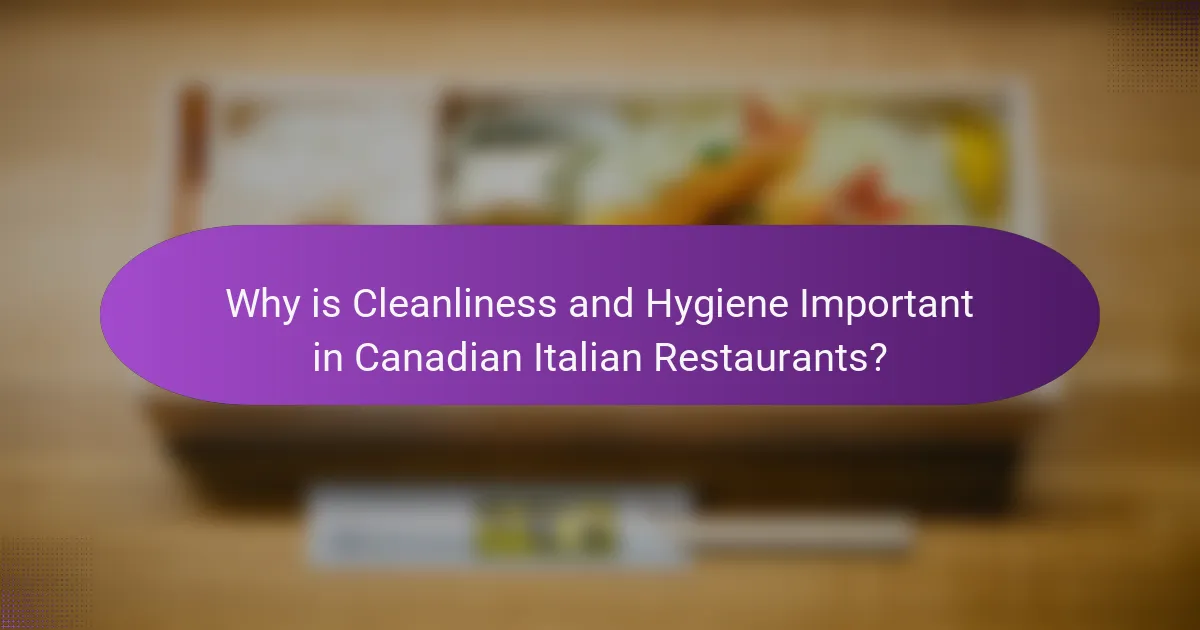
Why is Cleanliness and Hygiene Important in Canadian Italian Restaurants?
Cleanliness and hygiene are crucial in Canadian Italian restaurants to ensure food safety and customer health. Maintaining high standards prevents foodborne illnesses, which can arise from improper food handling. Health regulations mandate regular inspections to uphold these standards. A clean environment also enhances customer experience and satisfaction. Studies show that diners are more likely to return to restaurants that prioritize cleanliness. Furthermore, positive reviews often highlight hygiene practices, impacting a restaurant’s reputation. This correlation underscores the importance of maintaining cleanliness and hygiene in the competitive dining industry.
What are the key sanitization practices in these restaurants?
Key sanitization practices in Canadian Italian restaurants include regular cleaning and disinfecting of surfaces. Staff must wash hands frequently, especially after handling food. Equipment should be sanitized after each use to prevent cross-contamination. Food storage areas must be kept clean and organized. Restrooms require regular cleaning and restocking of supplies. Floors and dining areas need daily cleaning to maintain hygiene. These practices align with health regulations to ensure customer safety. Compliance with these standards is crucial for maintaining a positive reputation.
How do these practices vary across different establishments?
Sanitization practices vary significantly across different Canadian Italian restaurants. Some establishments implement rigorous cleaning protocols, while others may adhere to basic guidelines. Fine dining restaurants often invest in advanced sanitization equipment and staff training. In contrast, casual eateries might rely on less comprehensive methods. Health inspection scores also reflect these differences. Higher-rated restaurants typically demonstrate more consistent adherence to cleanliness standards. Customer perception plays a crucial role as well. Diners often prefer establishments with visible cleanliness practices, influencing their dining choices. Thus, the variation in practices directly impacts both operational success and customer satisfaction.
What specific cleaning protocols are commonly implemented?
Commonly implemented cleaning protocols in Canadian Italian restaurants include regular sanitization of surfaces and equipment. High-touch areas such as door handles and menus are cleaned frequently. Food preparation areas undergo routine deep cleaning to prevent cross-contamination. Dishwashing protocols require high-temperature sanitization. Staff receive training on proper cleaning techniques and hygiene practices. Restrooms are cleaned multiple times a day to maintain sanitation standards. Waste disposal procedures ensure that garbage is removed regularly. Health inspections verify compliance with these cleaning protocols to ensure public safety.
How do health inspections influence restaurant hygiene standards?
Health inspections significantly influence restaurant hygiene standards by enforcing compliance with health regulations. These inspections assess food safety practices, cleanliness, and overall sanitation. Restaurants that fail to meet hygiene standards may face fines or closure. Conversely, passing inspections encourages establishments to maintain high cleanliness levels. Regular inspections create accountability among restaurant owners. They also promote a culture of food safety within the industry. Research indicates that restaurants with high inspection scores attract more customers. This relationship highlights the importance of hygiene in customer perception and business success.
What criteria are used during health inspections?
Health inspections use criteria such as food safety practices, cleanliness, and employee hygiene. Inspectors assess food storage temperatures and cross-contamination risks. They evaluate the cleanliness of food preparation areas and equipment. Employee handwashing and use of gloves are also checked. Compliance with local health regulations is crucial. Inspectors may refer to the Food Safety Code for specific standards. Violations can lead to penalties or temporary closures. Regular inspections help maintain public health and safety standards.
How do inspection results impact restaurant operations?
Inspection results significantly impact restaurant operations by influencing compliance, reputation, and financial performance. Positive inspection results can enhance a restaurant’s credibility and attract more customers. Conversely, negative results can lead to operational changes, such as staff retraining or menu adjustments. Restaurants may face fines or closures due to repeated violations. According to a study by the National Restaurant Association, 75% of consumers consider food safety when choosing a restaurant. Thus, inspection outcomes directly affect customer trust and business sustainability.
Why does customer perception matter in relation to cleanliness?
Customer perception matters in relation to cleanliness because it directly influences dining choices. Cleanliness affects customers’ trust and satisfaction levels. A study by the Journal of Foodservice Business Research found that 70% of customers would not return to a restaurant perceived as dirty. Positive perceptions of cleanliness can enhance a restaurant’s reputation. This can lead to increased customer loyalty and word-of-mouth referrals. In contrast, negative perceptions can result in poor reviews and loss of business. Therefore, maintaining high cleanliness standards is essential for success in the restaurant industry.
What role does cleanliness play in customer satisfaction?
Cleanliness significantly impacts customer satisfaction in restaurants. A clean environment fosters a positive dining experience. Customers often associate cleanliness with food safety and quality. Studies show that 75% of diners consider cleanliness a top priority. In Canadian Italian restaurants, high cleanliness standards can enhance reputation. Regular health inspections reinforce trust in sanitation practices. Ultimately, cleanliness directly influences repeat business and customer loyalty.
How can poor hygiene affect a restaurant’s reputation?
Poor hygiene can severely damage a restaurant’s reputation. Customers often associate cleanliness with food safety. A dirty environment can lead to negative reviews and loss of trust. According to a survey by the National Restaurant Association, 75% of diners consider cleanliness a top priority. Poor hygiene may also result in health inspections failing. This can lead to fines or temporary closures. Social media amplifies negative experiences, spreading bad news quickly. Ultimately, poor hygiene can decrease customer loyalty and revenue.
What are the connections between sanitization practices and customer perception?
Sanitization practices significantly influence customer perception in restaurants. Cleanliness directly affects customers’ trust and comfort levels. A study by the Journal of Food Protection found that visible sanitation efforts increase consumer confidence. Customers are more likely to return to establishments that prioritize hygiene. Poor sanitization can lead to negative reviews and loss of business. Health inspections often reflect the sanitization practices of a restaurant. Higher inspection scores correlate with positive customer perceptions. Customers associate cleanliness with food safety and quality. Therefore, effective sanitization is crucial for maintaining a positive reputation.
How do health inspections affect customer trust in restaurants?
Health inspections significantly impact customer trust in restaurants. Positive inspection results enhance consumer confidence in food safety. Customers are more likely to patronize establishments with high hygiene ratings. Conversely, negative results can lead to decreased trust and customer loss. Studies show that 70% of diners consider health inspection scores before choosing a restaurant. Transparency in inspection results fosters trust and loyalty among patrons. Therefore, health inspections play a crucial role in shaping customer perceptions and behaviors.
What best practices can Canadian Italian restaurants adopt for improved hygiene?
Canadian Italian restaurants can adopt several best practices for improved hygiene. Regular handwashing is essential for all staff before handling food. Using gloves when preparing food can prevent cross-contamination. Clean and sanitize surfaces frequently, especially in food preparation areas. Implement a pest control program to keep the premises free of insects and rodents. Proper food storage is crucial; maintain appropriate temperatures for perishable items. Conduct regular training sessions for staff on hygiene protocols and food safety. Keeping a hygiene checklist can help ensure compliance with health regulations. These practices contribute to a safer dining environment and enhance customer trust.
How can staff training enhance sanitization efforts?
Staff training enhances sanitization efforts by equipping employees with essential knowledge and skills. Trained staff understand proper cleaning techniques and the importance of hygiene. They learn to identify high-touch surfaces that require frequent sanitization. Training also emphasizes the correct use of cleaning products and equipment. This reduces the risk of cross-contamination in food preparation areas. Furthermore, consistent training reinforces a culture of cleanliness within the restaurant. According to the Centers for Disease Control and Prevention (CDC), proper training can significantly lower foodborne illness risks. Well-trained staff contribute to better health inspection scores, improving overall customer perception.
What innovative tools can be used to maintain cleanliness?
Innovative tools for maintaining cleanliness include robotic vacuums and UV-C sanitizing devices. Robotic vacuums automate floor cleaning, reducing labor costs and improving efficiency. They can navigate various surfaces and reach tight spaces. UV-C sanitizing devices use ultraviolet light to kill germs on surfaces. These devices are effective in eliminating bacteria and viruses. Both tools enhance hygiene standards in environments like restaurants. Their adoption can lead to better health inspection outcomes. Studies show that improved cleanliness positively affects customer perception.
The main entity in this article is cleanliness and hygiene in Canadian Italian restaurants. The article outlines the critical role of sanitation practices in ensuring food safety and customer health, emphasizing the importance of regular health inspections and their impact on restaurant operations and reputation. It highlights key sanitization practices, variations across establishments, and the influence of customer perception on dining choices. Additionally, it discusses best practices for maintaining hygiene and the significance of staff training in enhancing cleanliness standards. Overall, the content underscores the direct correlation between hygiene, customer satisfaction, and business success in the competitive restaurant industry.


